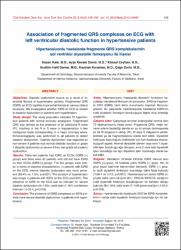Association of fragmented QRS complexes on ECG with left ventricular diastolic function in hypertensive patients

Göster/
Erişim
info:eu-repo/semantics/openAccessTarih
2015Yazar
Kadı, HasanDemir, Ayşe Kevser
Ceyhan, Köksal
Damar, İbrahim Halil
Karaman, Kayıhan
Zorlu, Çağrı
Üst veri
Tüm öğe kaydını gösterÖzet
Objectives: Diastolic dysfunction occurs as a result of interstitial fibrosis in hypertensive patients. Fragmented QRS (fQRS) on ECG signifies myocardial fibrosis in various clinical situations. We investigated whether fQRS on ECG is related to diastolic dysfunction in patients with hypertension. Study design: The study population included 72 hypertensive patients with normal coronary angiogram. Fragmented QRS was defined as the presence of an additional R wave (R'), notching of the R or S wave or fragmentation in two contiguous leads corresponding to a major coronary artery. Echocardiography was performed to all patients to detect diastolic dysfunction. Diastolic dysfunction was regarded as non-severe if patients had normal diastolic function or grade 1 diastolic dysfunction or severe if they had grade ≥2 diastolic dysfunction. Results: Thirty-two patients had fQRS on ECGs (fQRS [+] group) and there were 40 patients who did not have fQRS on their ECGs (fQRS [-] group). The two groups were similar in terms of baseline characteristics. In patients with fQRS on the ECG, severe diastolic dysfunction was more prevalent (59.4% vs. 7.5%, p<0.001). The duration of hypertension was longer in patients with fQRS on the ECG (p<0.001). The presence of fQRS on the ECG was an indicator for severe diastolic dysfunction (B=1.954; odds ratio=7; 95% confidence interval=1.4-35.4; p=0.018). Conclusion: The presence of fQRS complexes on ECG predicts more severe diastolic dysfunction in patients with hypertension. Amaç: Hipertansiyonlu hastalarda diyastolik fonksiyon bozukluğu interstisiyel fibrozun bir sonucudur. EKG’de fragmente QRS (fQRS) farklı klinik durumlarda miyokart fibrozunu
gösterir. Bu çalışmada, hipertensiyonlu hastalarda fQRS’nin
ciddi diyastolik fonksiyon bozukluğuyla ilişkisi olup olmadığı
araştırıldı.
Çalışma planı: Çalışmaya koroner anjiyografisi normal olan
72 hipertansiyonlu hasta alındı. Fragmente QRS, majör koroner arterin beslediği alanda en az iki ardışık derivasyonda
ek bir R dalgasının varlığı (R’), R veya S dalgasının çentiklenmesi ya da fragmentasyonu olarak tarif edildi. Diyastolik
fonksiyon bozukluğunu belirlemek için tüm hastalara ekokardiyografi yapıldı. Normal diyastolik işlevler veya evre 1 diyastolik işlev bozukluğu ağır olmayan, evre 2 veya üstü diyastolik
işlev bozukluğu ise ağır diyastolik işlev bozukluğu olarak kabul edildi.
Bulgular: Hastaların 32’sinde EKG’de fQRS mevcut iken
(fQRS [+] grup), 40 hastada yoktu (fQRS [–] grup). Her iki
grup bazal özellikler bakımından benzerdi. fQRS (+) grupta ciddi diyastolik fonksiyon bozukluğu daha fazla bulundu
(%59.4 ve %7.5, p<0.001). Hipertansiyonun süresi fQRS (+)
grupta daha uzun idi (p<0.001). EKG’de fQRS’nin varlığının
ciddi diyastolik fonksiyon bozukluğunun bir belirteci olduğu
bulundu (B=1.954; odds oranı=7; %95 güven aralığı=1.4-35.4;
p=0.018).
Sonuç: Hipertansiyonlu hastalarda EKG’de fQRS komplekslerinin varlığı ciddi diyastolik fonksiyon bozukluğu için bir belirteçtir.

















